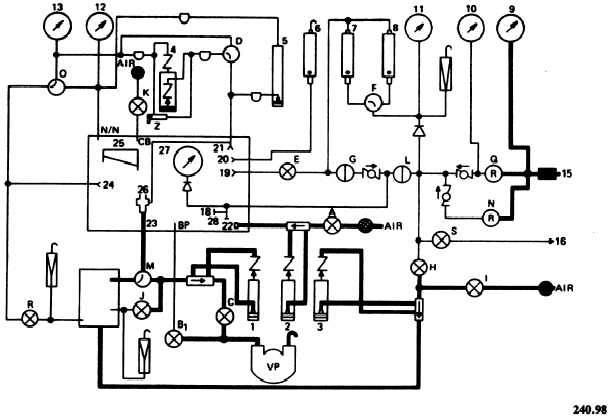large volume of air into the altitude chamber.
When you open the chamber bleed valve (K),
ambient air flows into the chamber through the
chamber bleed port (CB). The altitude in the
chamber drops until the pressure inside the
chamber equalizes with the pressure at sea level.
PRESSURIZING THE CHAMBER
BLEED SYSTEM
Open the vacuum control valve (B1) and
ascend to 10,000 feet; then close the valve to
stabilize your altitude. A drop in altitude on the
low-range altimeter (13) indicates a leak. If there
is no drop in altitude, open the chamber bleed
valve (K) and descend to sea level. When you
reach sea level, close the chamber bleed valve (K).
The test stand is now ready to test the flow
measuring system.
FLOW MEASURING SYSTEM
This system is the largest and most important
system on the test stand. The purpose of the flow
measuring system is to measure flows of air,
nitrogen, or air/nitrogen mixture from an item
under test. As you can see in figure 2-11, the
system consists of vol-o-flow elements, flow
indicating manometers, control valves, and selec-
tor valves. The flow measuring system is made
up of the output, input, and vent flow subsystems.
The different subsystems function with the
vacuum running.
Output
The output flow system originates at the
piezometer (26) and flows through the output
port (23) to the flow selector valve (M). It
is then directed to either the output vol-o-flow
e l e m e n t o r t h e s u i t s i m u l a t o r t a n k . W h en
the flow selector valve (M) is placed in the
REGULATOR position, the flow is directed
to the output vol-o-flow element. The volume
of flow is controlled by the output valve (C) and
is indicated on the output flow manometer (l).
The only time this system is used with the flow
selector valve (M) in the SUIT SIMULATOR
position is when the full pressure suit breathing
regulator is tested.
Figure 2-11.—Model 1172AS100 flow measuring system.
2-12

